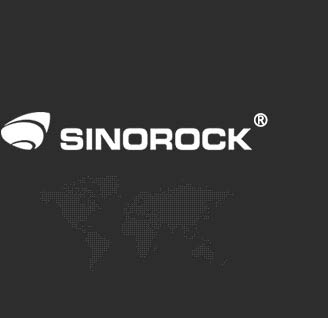Application of Self-Drilling Anchor Bolts in Catastrophic Slope Stabilization
Time:2025-11-19From:sinorock View:
Catastrophic slopes refer to landslides and collapses triggered by heavy rainfall, earthquakes, or engineering activities that pose serious threats to human life, property, and infrastructure. Traditional slope reinforcement methods (such as conventional anchor bolts and retaining walls) often face challenges in complex geological conditions and emergency situations, including long construction periods, difficult drilling, and poor immediate stability. This article provides an in-depth analysis of the application scenarios, advantages, and key construction points of self-drilling anchor bolts in catastrophic slope management.
1. Challenges in Catastrophic Slope Support
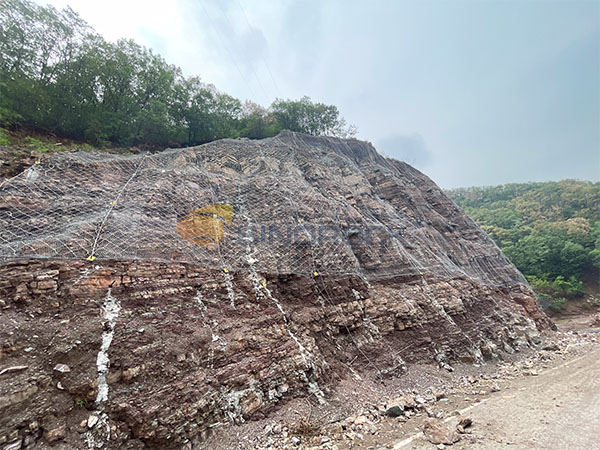
Complex Geological Conditions
Catastrophic slopes are often composed of loose accumulations, fault fracture zones, highly weathered rock, sandy soil layers, and soft soil with high water content. These uncertain factors significantly increase the difficulty of investigation and design, making it difficult for traditional support methods to accurately control support depth and anchorage effectiveness.
Susceptibility to Repeated Deformation
Under heavy rainfall, sudden earthquakes, or construction disturbances, catastrophic slopes may experience rapid instability or repeated deformation within an extremely short time. Traditional anchor bolt construction has a long cycle and cannot form effective support in time, easily leading to secondary disasters or further expansion of the instability zone.
Limited Working Space
Catastrophic slopes are typically located in mountainous areas, roadsides, or canyons, where working platforms are narrow or completely nonexistent. Large drilling rigs cannot access the site, material transportation is difficult, and construction safety risks are high.
Need for Simultaneous Construction and Stabilization
The loose structure of catastrophic slopes means that the support construction process itself may cause additional disturbance, leading to further displacement or even local collapse. Therefore, the principle of "construction equals support" must be maintained, which places higher demands on construction methods, equipment, and materials.
2. Main Application Scenarios of Self-Drilling Anchor Bolts in Catastrophic Slopes
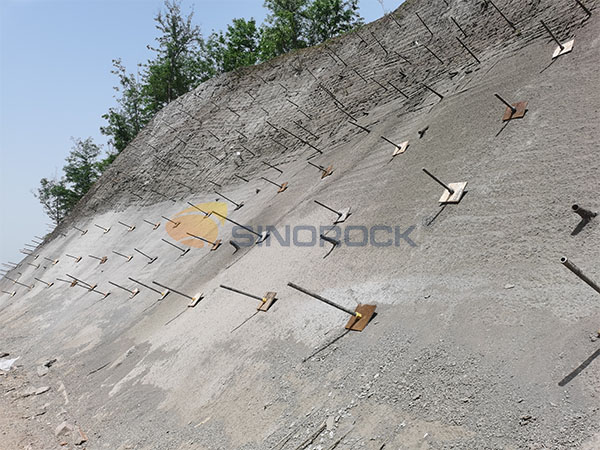
Self-drilling anchor bolts have become a key technology in various catastrophic slope management scenarios due to their efficient construction performance and reliable reinforcement effectiveness.
Emergency Landslide Treatment
Scenario characteristics: The landslide body has a loose structure and poor stability, requiring rapid deformation control.
Solution: Rapidly deploy self-drilling anchor bolts in the active sliding zone at the front and middle sections of the landslide body, forming a preliminary support system with surface structures to quickly provide anti-sliding force, gaining time for subsequent comprehensive treatment and creating safe working conditions.
Reinforcement of Collapsing Dangerous Rock Masses
Scenario characteristics: Rocks separated from the parent rock mass, including dangerous stones and isolated boulders, with risk of falling.
Solution: Penetrate the dangerous rock mass with self-drilling anchor bolts and anchor them into stable bedrock at depth. Through grouting, the slurry penetrates into fissures, achieving active anchorage and locking of the dangerous rock mass.
Emergency Repair of Transportation Corridor Slopes
Scenario characteristics: Local instability in highway and railway slopes requires rapid reinforcement to ensure traffic safety, with often limited working space.
Solution: Utilize the miniaturization and integrated process advantages of self-drilling anchor bolt equipment to achieve rapid site access and efficient construction, completing reinforcement of unstable areas with minimal working surface and minimizing traffic disruption.
Pre-reinforcement and Emergency Repair of Foundation Pit Projects
Scenario characteristics: Deep foundation pit projects adjacent to important buildings with extremely strict deformation control requirements for slopes.
Solution: Pre-reinforce potential slip surfaces before excavation to enhance soil self-stability; can serve as an effective emergency reinforcement measure when risks arise.
3. Core Advantages of Self-Drilling Anchor Bolts in Catastrophic Slopes
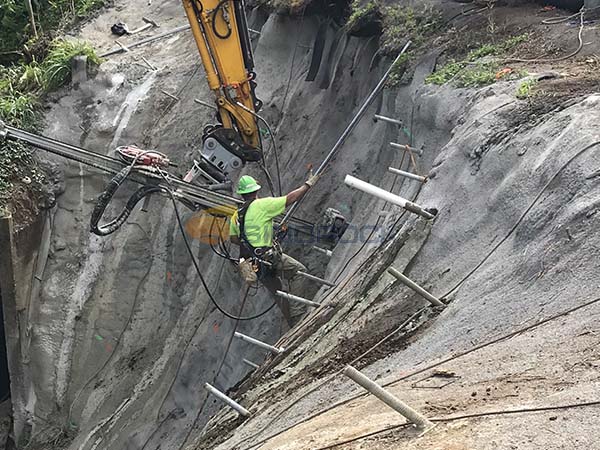
Self-drilling anchor bolts are an advanced geotechnical engineering technology that integrates drilling, grouting, and anchoring into one. The core component is a hollow anchor bolt body with a drill bit at the front end. During construction, it drills directly into the rock and soil mass through a drilling rig while simultaneously performing high-pressure grouting through the hollow channel. The slurry overflows from the drill bit, fills the borehole, and combines tightly with the surrounding rock and soil mass, forming a high-strength composite anchorage body. When facing catastrophic slopes, the advantages of self-drilling anchor bolts are particularly prominent:
Excellent Immediate Support Capability
Traditional anchor bolts require drilling first, withdrawing the drill rod, and then inserting the anchor bolt—a process that easily causes hole collapse in loose, fractured landslide bodies. Self-drilling anchor bolts provide "drill-in-place support," with the drill rod itself serving as the anchor bolt, immediately providing support force, effectively controlling deformation, and gaining precious time for subsequent construction.
Adaptability to Complex Geological Conditions
In formations difficult to drill such as gravelly soil, highly weathered rock, and accumulation layers, self-drilling anchor bolts demonstrate strong adaptability. Their "drill-and-grout" process can effectively consolidate surrounding loose rock and soil masses, forming a reinforced body stronger than the original soil.
High Construction Efficiency and Short Duration
Simplifying multiple procedures into one, construction is fast, making it highly suitable for emergency rescue and disaster relief projects. It can quickly form an anchoring system, rapidly stabilize the landslide body, and minimize disaster losses to the greatest extent.
High Load-Bearing Capacity and Reliable Durability
Full-process high-pressure grouting allows the slurry to fully penetrate into geological fissures, forming "tree-root-shaped" anchor roots that significantly increase the contact area between the anchorage body and the formation, thereby providing higher anchoring force. Complete encapsulation of the anchor bolt body by the slurry also provides excellent corrosion protection.
4. Construction Process for Self-Drilling Anchor Bolts on Slopes

Construction on catastrophic slopes must strictly follow specifications to ensure safety and quality:
Slope Surface Preparation: Remove loose stones and apply preliminary protection with mesh-reinforced shotcrete.
Survey and Layout: Determine anchor bolt positions, typically in a quincunx pattern with spacing of 1.5-3m.
Drilling and Grouting: Connect the drilling rig and grouting machine, drill and grout simultaneously (water-cement ratio 0.45-0.5) to the design depth.
Extension and Supplementary Grouting: Use connecting sleeves to extend extra-long anchor bolts, perform secondary pressure grouting to ensure fullness.
Install Accessories: Install bearing plates and nuts, apply tension locking (for prestressed type).
Combined Support: Often used in combination with frame beams, active nets, and shotcrete.
Testing and Acceptance: Pull-out test (not less than 1.5 times the design value), monitor displacement.
5. Key Technical Points in Self-Drilling Anchor Bolt Design and Construction
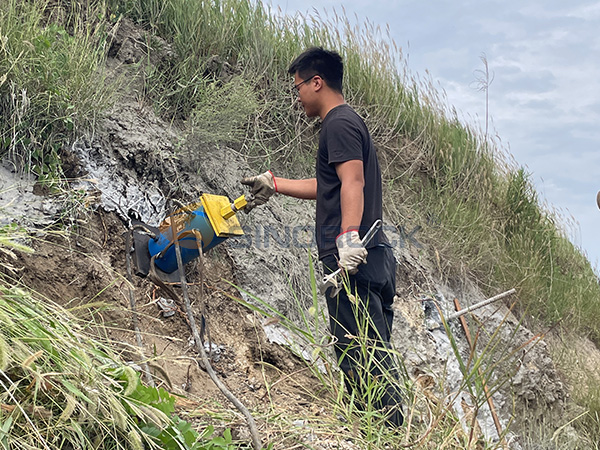
To ensure project effectiveness, the following technical aspects should be emphasized in design and construction:
Grouting Process Control
Slurry proportioning: Design water-cement ratio based on geological conditions, typically using pure cement slurry with a ratio of 0.4-0.5; admixtures can be added according to project needs to adjust workability and setting time.
Grouting pressure: Employ staged grouting process. Initial stages use lower pressure to ensure slurry fills the borehole, followed by staged pressure increases to ensure effective penetration of the slurry into the surrounding ground mass and formation of the anchoring section.
Anchorage System Design
Layout parameters: Anchor bolt spacing, length, and inclination angle must be determined through geotechnical engineering calculations. The layout principle is to ensure the anchoring section is located in stable strata and forms an effective group reinforcement effect.
Load design: Calculate required anchoring force based on slope stability analysis, then determine anchor bolt model, diameter, and quantity accordingly.
Construction Process Control
Drilling control: Adjust drilling speed and torque according to geological conditions to ensure straight boreholes and reduce disturbance to the formation.
Quality verification: Ensure grouting body fullness by checking grouting volume and monitoring grouting pressure. For important projects, anchor bolt acceptance tests must be conducted according to specifications to verify that load-bearing capacity meets design requirements.
6. Conclusion
When dealing with time-critical catastrophic slopes in adverse geological conditions, self-drilling anchor bolts have become an indispensable tool in modern geotechnical engineering due to their integrated design, rapid construction, and excellent support effectiveness. They not only provide technical solutions but also play a crucial role in disaster prevention and mitigation and ensuring public safety. For project decision-makers, choosing self-drilling anchor bolt technology means choosing efficiency, reliability, and safety.
latest news
-
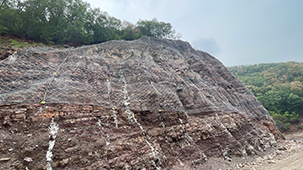
- Application of Self-Drilling Anchor Bolts in Catastrophic Slope Stabilization
- Time:2025-11-19From:This Site
- Learn how self-drilling anchor bolts provide rapid, effective solutions for catastrophic slope stabilization in landslides, rockfalls, and emergency scenarios.
- View details
-
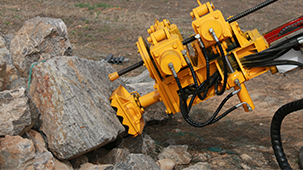
- How Self-Drilling Anchor Bolts Drill and Grout Simultaneously
- Time:2025-11-17From:This Site
- Discover how self-drilling anchor bolts drill and grout simultaneously, improving efficiency, stability, and safety in geotechnical projects. Learn the mechanism, installation process, advantages, and common applications.
- View details
-
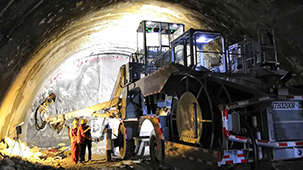
- Self-Drilling Pipe Umbrella vs. Advance Small-Diameter Pipes in Tunnel Support
- Time:2025-11-15From:This Site
- Compare self-drilling pipe umbrellas and advance small-diameter pipes in tunnel support. Learn their working principles, advantages, limitations, and real-world applications to choose the most effective pre-support solution for safe and efficient underground construction.
- View details
-
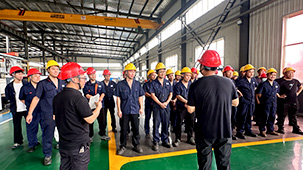
- Sinorock 2025 Quality Month | Strengthening Quality Foundations, Empowering Product Excellence
- Time:2025-08-13From:This Site
- Sinorock’s 2025 Quality Month, themed “Strengthening Quality Foundations, Empowering Product Excellence,” successfully concluded, reinforcing our commitment to superior product quality.
- View details
-
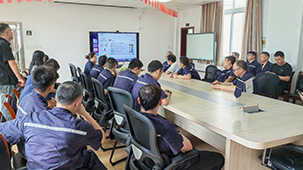
- Sinorock Safety Month 2025 | Everyone Speaks Safety, Everyone Can Respond
- Time:2025-07-03From:This Site
- Sinorock Safety Month 2025, centered on the theme "Everyone Speaks Safety, Everyone Can Respond - Spot Workplace Hazards," has wrapped up successfully!
- View details
-
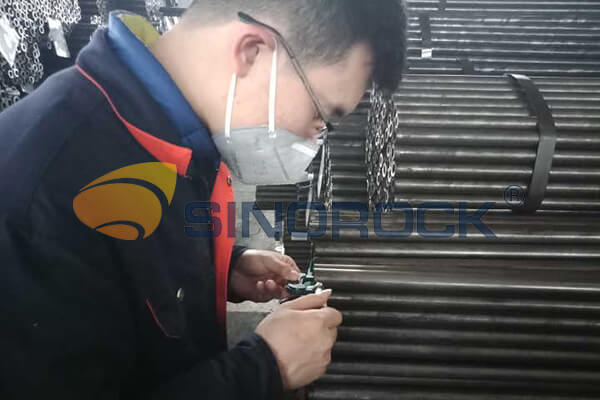
- Quality Control: the Vital Factor of A SDA Bolt Factory
- Time:2025-01-09From:This Site
- Sinorock’s comprehensive quality control system, from supplier management to outgoing inspections, ensuring the highest standards for self-drilling anchor bolts in construction.
- View details
-

- SINOROCK to Showcase Innovative Mining Solutions at Mining and Metals Central Asia 2025
- Time:2025-09-09From:This Site
- We are pleased to share that SINOROCK will participate in the Mining and Metals Central Asia 2025, taking place from September 17 to 19 at the Atakent International Exhibition Centre in Almaty, Kazakhstan. You can find us at Booth 11-231.
- View details
-

- Sinorock Invites You to Explore Proven Self-Drilling Anchor Bolt Solutions at bauma 2025
- Time:2025-03-07From:This Site
- From April 7–13, 2025, explore Sinorock’s Self-drilling anchor bolt solution at Booth C2.513/4 in Hall C2 of the Messe München Exhibition Center (Munich, Germany).
- View details
-
.jpg)
- SINOROCK to Attend EXPOMINA PERÚ 2024 in Lima, Peru
- Time:2024-08-10From:This Site
- Sinorock to Attend EXPOMINA PERÚ 2024 in Lima, Peru
- View details
 Download
Download 

